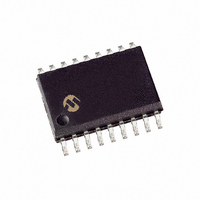MCP2140A-I/SO Microchip Technology, MCP2140A-I/SO Datasheet - Page 21

MCP2140A-I/SO
Manufacturer Part Number
MCP2140A-I/SO
Description
IC IRDA CONTROLLR DTE/DCE 18SOIC
Manufacturer
Microchip Technology
Specifications of MCP2140A-I/SO
Package / Case
18-SOIC (7.5mm Width)
Controller Type
IRDA Standard Protocol Stack Controller
Interface
UART
Voltage - Supply
3 V ~ 5.5 V
Current - Supply
2.2mA
Operating Temperature
-40°C ~ 125°C
Mounting Type
Surface Mount
Product
Controller Area Network (CAN)
Maximum Operating Temperature
+ 85 C
Minimum Operating Temperature
- 40 C
Mounting Style
SMD/SMT
Ic Function
Standard Protocol Stack Controller
Brief Features
Includes UART-to-IrDA Standard Encoder/decoder Functionality, Infrared Supported
Supply Voltage Range
2V To 5.5V
Rohs Compliant
Yes
Lead Free Status / RoHS Status
Lead free / RoHS Compliant
For Use With
MCP2140DM-TMPSNS - BOARD DEMO FOR MCP2140
Lead Free Status / Rohs Status
Lead free / RoHS Compliant
Available stocks
Company
Part Number
Manufacturer
Quantity
Price
Company:
Part Number:
MCP2140A-I/SO
Manufacturer:
MICROCHIP
Quantity:
12 000
Part Number:
MCP2140A-I/SO
Manufacturer:
MICROCHIP/微芯
Quantity:
20 000
2.10.2
Actual maximum throughput is dependent on several
factors, including:
• Characteristics of the Primary device
• Characteristics of the MCP2140A
• IrDA standard protocol overhead
• Direction of Data Transmitted
2.10.2.1
While the characteristics of the MCP2140A are fixed,
the characteristics of the Primary Device may be made
better, or worse, depending on the implementation of
the Primary Device’s application program.
IrDA Standard protocol overhead limits the maximum
throughput to much less then the 9600 baud bit rate.
2.10.2.2
The IrDA standard specifies how the data is passed
between the Primary device and Secondary device. In
IrCOMM, an additional 8 bytes are used by the protocol
for each packet transfer. In the IrCOMM 9-wire
“cooked” service class, 4 bytes of the 64 byte payload
are overhead bytes. That leaves a maximum of
60 bytes that can be transferred per “frame”.
The most significant factor in data throughput is how
well the data frames are filled. If only 1 byte is sent at a
time, the throughput overhead of the IrCOMM protocol
is 89% (see
throughput is to align the amounts of data with the
receive buffer (IR and Host UART) packet size of the
MCP2140A.
TABLE 2-1:
© 2007 Microchip Technology Inc.
MCP2140A
Host UART
IR Receive
Receive
Note 1: Overhead % =
2: The maximum number of data bytes in the
3: The maximum number of bytes of the Host
4: The CTS signal is driven high after the 59
IMPROVING THROUGHPUT
IR Receive frame.
UART Receive buffer.
byte.
Characteristics of the Primary
Device and the MCP2140A
IrDA Standard Protocol Overhead
(Bytes)
Packet
Table
Size
Data
Overhead/(Overhead + Data).
60
60
1
1
IRCOMM OVERHEAD %
2-1). The best way to maximize
Overhead
IrCOMM
(Bytes)
8
8
8
8
Overhead
IrCOMM
12 %
89 %
12 %
89 %
%
(1)
Comment
Note 2
Note 3,
Note 4
2.10.2.3
Due to the different characteristics of the Primary
Device and the Secondary Device, the data throughput
between two devices may be substantially different
depending on the direction the data is being trans-
ferred. This is shown in
MCP2140A to Primary Device
One of the factors to improve throughput is to ensure
the Host Controller keeps the MCP2140A UART
Receive Buffer full (60 bytes) to maximize the data
bytes sent per IR frame.
waveform, what the state of the buffers can be and the
operation of the Host UART and IR interfaces.
A second is to minimize the turn around response time
from the Primary device, if possible.
Primary Device to MCP2140A
In this case, ensure that the Host Controller can receive
data as fast as possible from the MCP2140A without
requiring to force the RTS high and delay the data from
being received by the Host Controller.
2.10.2.4
The MCP2140A uses a fixed IR Receiver data block
size of 64 bytes.
The minimum size frame the Primary device can
respond with is 6 bytes.
2.10.2.5
The MCP2140A uses a fixed Host UART Receiver data
block size of 60 bytes.
2.11
An IR link can be compared to a one-wire data connec-
tion. The IR transceiver can transmit or receive, but not
both at the same time. A delay of one bit time is
recommended between the time a byte is received and
another byte is transmitted.
2.12
The MCP2140A has a fixed Device ID. This Device ID
is “MCP2140A XX”, with the xx indicating the silicon
revision of the device.
Turnaround Latency
Device ID
Direction of Data Transmitted
From the Primary Device
From the MCP2140A
Table
MCP2140A
Figure 2-10
2-4.
DS22050A-page 21
shows the CTS

















